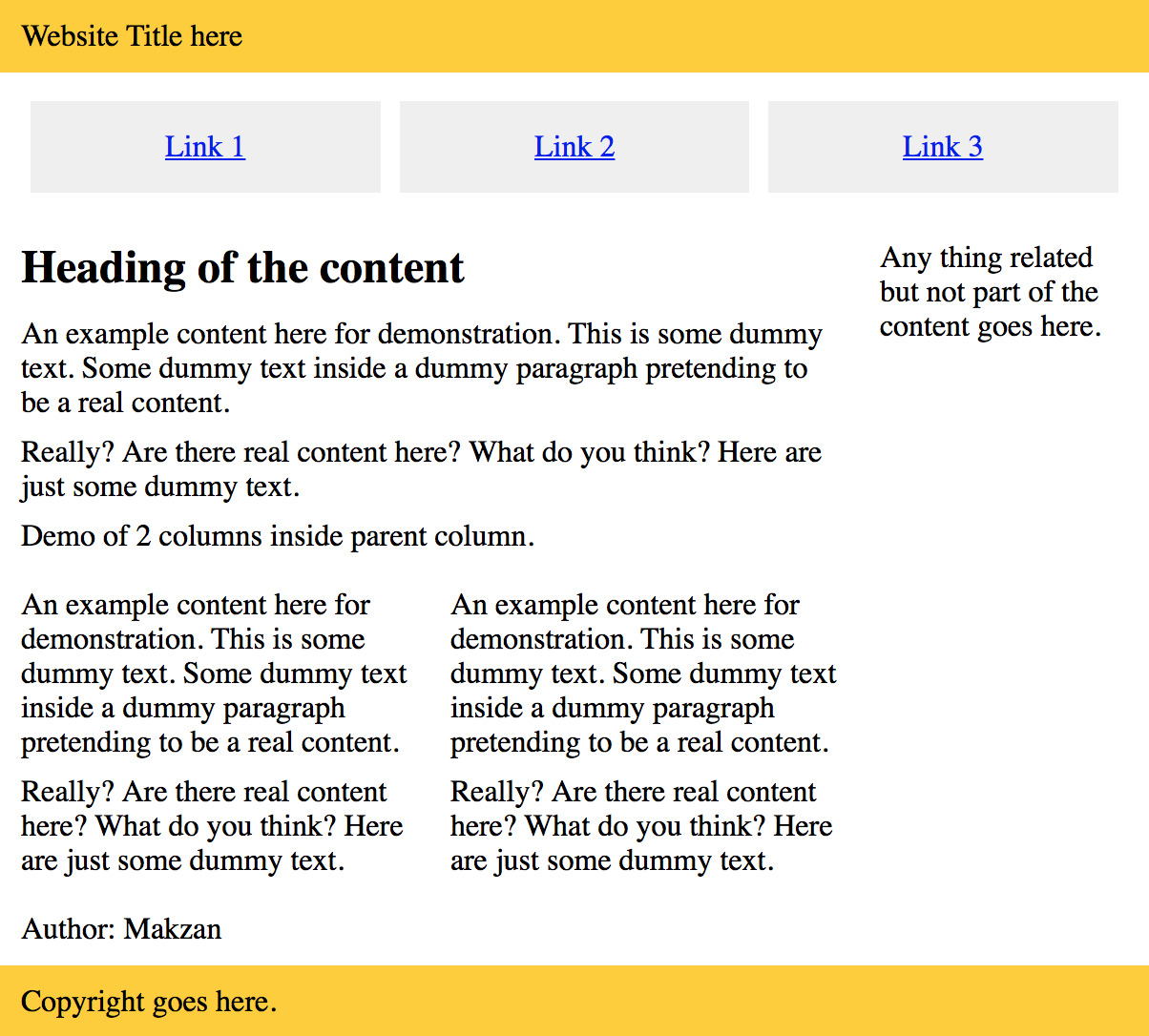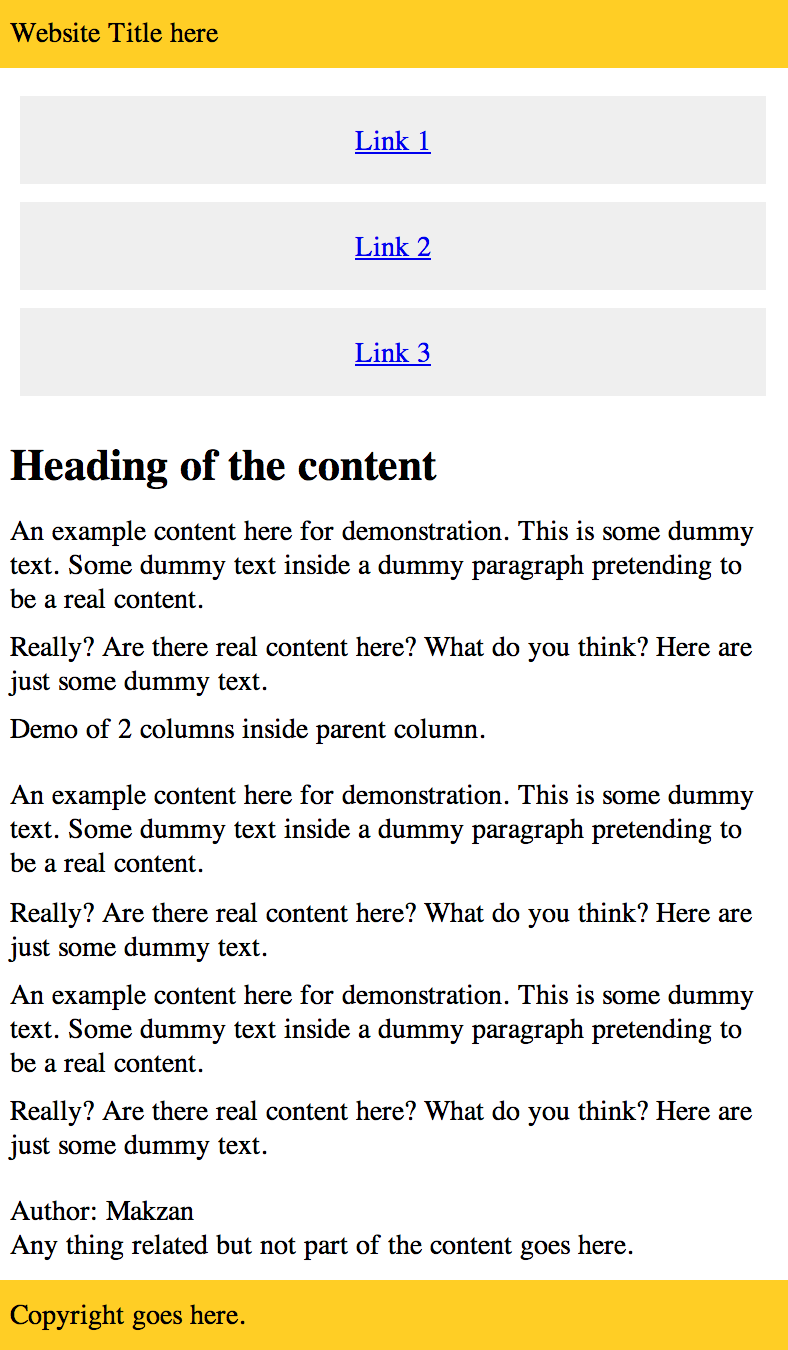Newest ⟷ Oldest
-
Snapshot at 2017-04-19
Building our own grid system
The following CSS demonstrates a minimal grid system I created. It is inspired from the Zurb Foundation and I just keep the most essential part - the basic grid.
You will find that actually it takes less than 50 lines of code to build a responsive grid system with row/column approach.
By creating our own grid system, we learn the core of the row/ column grid. One more benefit is that we can use a basic grid at the beginning of the project. And only include the Foundation framework into the project until we need their rich features.
Video
https://codepen.io/makzan/pen/pPgerL?editors=1100
Code
* { box-sizing: border-box; } img { max-width: 100%; } .row { width: 100%; max-width: 600px; margin: 0 auto; padding-top: 10px; padding-bottom: 10px; } .row .row { width: auto; max-width: none; margin: 0 -10px; } .col { padding: 0 10px; width: 100%; } @media screen and (min-width: 500px) { .row { overflow: auto; } .col { float:left; } .one { width: 25%; } .two { width: 50%; } .three { width: 75%; } .four { } }And the sample HTML that uses our CSS grid.
<header> <div class="row"> <div class="four col"> Website Title here </div> </div> </header> <nav> <div class="row"> <div class="four col"> <ul> <li><a href='#'>Link 1</a></li> <li><a href='#'>Link 2</a></li> <li><a href='#'>Link 3</a></li> </ul> </div> </div> </nav> <div class="row"> <div class="three col"> <article> <header> <h1>Heading of the content</h1> </header> <p>Content.</p> <p>Demo of 2 columns inside parent column.</p> <div class="row"> <div class="two col"> <p>Content.</p> </div> <div class="two col"> <p>Content.</p> </div> </div> <footer> Content </footer> </article> </div> <div class="one col"> <aside> Any thing related but not part of the content goes here. </aside> </div> </div> <footer> <div class="row"> <div class="four col"> Copyright goes here. </div> </div> </footer>Results


Examples
An example of the grid system with placeholder image.
https://codepen.io/makzan/pen/vmLNOV
An example of using our grid system with the block-grid navigation approach.
https://codepen.io/makzan/pen/EmPVVv
An example of using our grid system with the footer navigation approach.
-
Snapshot at 2017-04-19
Building our own grid system
The following CSS demonstrates a minimal grid system I created. It is inspired from the Zurb Foundation and I just keep the most essential part - the basic grid.
You will find that actually it takes less than 50 lines of code to build a responsive grid system with row/column approach.
By creating our own grid system, we learn the core of the row/ column grid. One more benefit is that we can use a basic grid at the beginning of the project. And only include the Foundation framework into the project until we need their rich features.
Code
* { box-sizing: border-box; } img { max-width: 100%; } .row { width: 100%; max-width: 600px; margin: 0 auto; padding-top: 10px; padding-bottom: 10px; } .row .row { width: auto; max-width: none; margin: 0 -10px; } .col { padding: 0 10px; width: 100%; } @media screen and (min-width: 500px) { .row { overflow: auto; } .col { float:left; } .one { width: 25%; } .two { width: 50%; } .three { width: 75%; } .four { } }And the sample HTML that uses our CSS grid.
<header> <div class="row"> <div class="four col"> Website Title here </div> </div> </header> <nav> <div class="row"> <div class="four col"> <ul> <li><a href='#'>Link 1</a></li> <li><a href='#'>Link 2</a></li> <li><a href='#'>Link 3</a></li> </ul> </div> </div> </nav> <div class="row"> <div class="three col"> <article> <header> <h1>Heading of the content</h1> </header> <p>Content.</p> <p>Demo of 2 columns inside parent column.</p> <div class="row"> <div class="two col"> <p>Content.</p> </div> <div class="two col"> <p>Content.</p> </div> </div> <footer> Content </footer> </article> </div> <div class="one col"> <aside> Any thing related but not part of the content goes here. </aside> </div> </div> <footer> <div class="row"> <div class="four col"> Copyright goes here. </div> </div> </footer>Results


Examples
An example of the grid system with placeholder image.
https://codepen.io/makzan/pen/vmLNOV
An example of using our grid system with the block-grid navigation approach.
https://codepen.io/makzan/pen/EmPVVv
An example of using our grid system with the footer navigation approach.
-
Snapshot at 2017-04-19
Building our own grid system
The following CSS demonstrates a minimal grid system I created. It is inspired from the Zurb Foundation and I just keep the most essential part - the basic grid.
You will find that actually it takes less than 50 lines of code to build a responsive grid system with row/column approach.
By creating our own grid system, we learn the core of the row/ column grid. One more benefit is that we can use a basic grid at the beginning of the project. And only include the Foundation framework into the project until we need their rich features.
* { box-sizing: border-box; } img { max-width: 100%; } .row { width: 100%; max-width: 600px; margin: 0 auto; padding-top: 10px; padding-bottom: 10px; } .row .row { width: auto; max-width: none; margin: 0 -10px; } .col { padding: 0 10px; width: 100%; } @media screen and (min-width: 500px) { .row { overflow: auto; } .col { float:left; } .one { width: 25%; } .two { width: 50%; } .three { width: 75%; } .four { } }And the sample HTML that uses our CSS grid.
<header> <div class="row"> <div class="four col"> Website Title here </div> </div> </header> <nav> <div class="row"> <div class="four col"> <ul> <li><a href='#'>Link 1</a></li> <li><a href='#'>Link 2</a></li> <li><a href='#'>Link 3</a></li> </ul> </div> </div> </nav> <div class="row"> <div class="three col"> <article> <header> <h1>Heading of the content</h1> </header> <p>Content.</p> <p>Demo of 2 columns inside parent column.</p> <div class="row"> <div class="two col"> <p>Content.</p> </div> <div class="two col"> <p>Content.</p> </div> </div> <footer> Content </footer> </article> </div> <div class="one col"> <aside> Any thing related but not part of the content goes here. </aside> </div> </div> <footer> <div class="row"> <div class="four col"> Copyright goes here. </div> </div> </footer>

An example of the grid system with placeholder image.
https://codepen.io/makzan/pen/vmLNOV
An example of using our grid system with the block-grid navigation approach.
https://codepen.io/makzan/pen/EmPVVv
An example of using our grid system with the footer navigation approach.
-
Snapshot at 2017-04-19
Building our own grid system
The following CSS demonstrates a minimal grid system I created. It is inspired from the Zurb Foundation and I just keep the most essential part - the basic grid.
You will find that actually it takes less than 50 lines of code to build a responsive grid system with row/column approach.
By creating our own grid system, we learn the core of the row/ column grid. One more benefit is that we can use a basic grid at the beginning of the project. And only include the Foundation framework into the project until we need their rich features.
* { box-sizing: border-box; } img { max-width: 100%; } .row { width: 100%; max-width: 600px; margin: 0 auto; padding-top: 10px; padding-bottom: 10px; } .row .row { width: auto; max-width: none; margin: 0 -10px; } .col { padding: 0 10px; width: 100%; } @media screen and (min-width: 500px) { .row { overflow: auto; } .col { float:left; } .one { width: 25%; } .two { width: 50%; } .three { width: 75%; } .four { } }And the sample HTML that uses our CSS grid.
<header> <div class="row"> <div class="four col"> Website Title here </div> </div> </header> <nav> <div class="row"> <div class="four col"> <ul> <li><a href='#'>Link 1</a></li> <li><a href='#'>Link 2</a></li> <li><a href='#'>Link 3</a></li> </ul> </div> </div> </nav> <div class="row"> <div class="three col"> <article> <header> <h1>Heading of the content</h1> </header> <p>Content.</p> <p>Demo of 2 columns inside parent column.</p> <div class="row"> <div class="two col"> <p>Content.</p> </div> <div class="two col"> <p>Content.</p> </div> </div> <footer> Content </footer> </article> </div> <div class="one col"> <aside> Any thing related but not part of the content goes here. </aside> </div> </div> <footer> <div class="row"> <div class="four col"> Copyright goes here. </div> </div> </footer>

An example of the grid system with placeholder image.
https://codepen.io/makzan/pen/vmLNOV
An example of using our grid system with the block-grid navigation approach.
https://codepen.io/makzan/pen/EmPVVv
An example of using our grid system with the footer navigation approach.
-
Snapshot at 2017-04-19
Building our own grid system
The following CSS demonstrates a minimal grid system I created. It is inspired from the Zurb Foundation and I just keep the most essential part - the basic grid.
You will find that actually it takes less than 50 lines of code to build a responsive grid system with row/column approach.
By creating our own grid system, we learn the core of the row/ column grid. One more benefit is that we can use a basic grid at the beginning of the project. And only include the Foundation framework into the project until we need their rich features.
* { box-sizing: border-box; } img { max-width: 100%; } .row { width: 100%; max-width: 600px; margin: 0 auto; padding-top: 10px; padding-bottom: 10px; } .row .row { width: auto; max-width: none; margin: 0 -10px; } .col { padding: 0 10px; width: 100%; } @media screen and (min-width: 500px) { .row { overflow: auto; } .col { float:left; } .one { width: 25%; } .two { width: 50%; } .three { width: 75%; } .four { } }And the sample HTML that uses our CSS grid.
<header> <div class="row"> <div class="four col"> Website Title here </div> </div> </header> <nav> <div class="row"> <div class="four col"> <ul> <li><a href='#'>Link 1</a></li> <li><a href='#'>Link 2</a></li> <li><a href='#'>Link 3</a></li> </ul> </div> </div> </nav> <div class="row"> <div class="three col"> <article> <header> <h1>Heading of the content</h1> </header> <p>Content.</p> <p>Demo of 2 columns inside parent column.</p> <div class="row"> <div class="two col"> <p>Content.</p> </div> <div class="two col"> <p>Content.</p> </div> </div> <footer> Content </footer> </article> </div> <div class="one col"> <aside> Any thing related but not part of the content goes here. </aside> </div> </div> <footer> <div class="row"> <div class="four col"> Copyright goes here. </div> </div> </footer>

An example of the grid system with placeholder image.
https://codepen.io/makzan/pen/vmLNOV
An example of using our grid system with the block-grid navigation approach.
https://codepen.io/makzan/pen/EmPVVv
An example of using our grid system with the footer navigation approach.